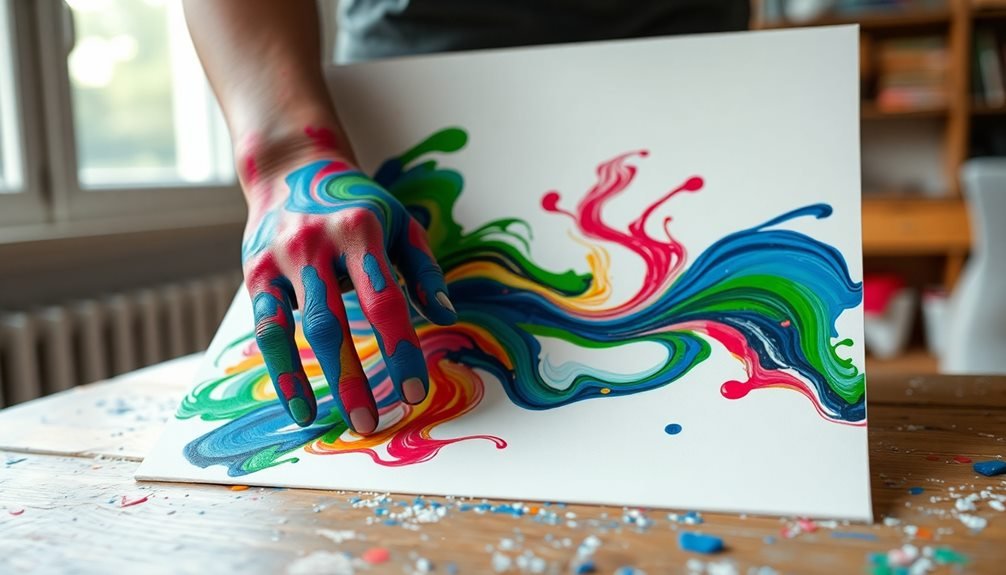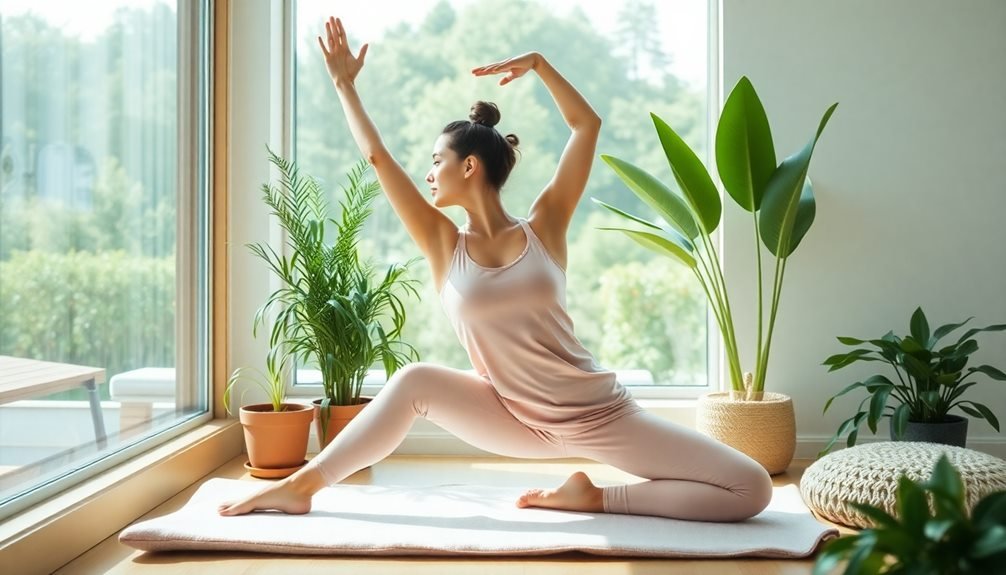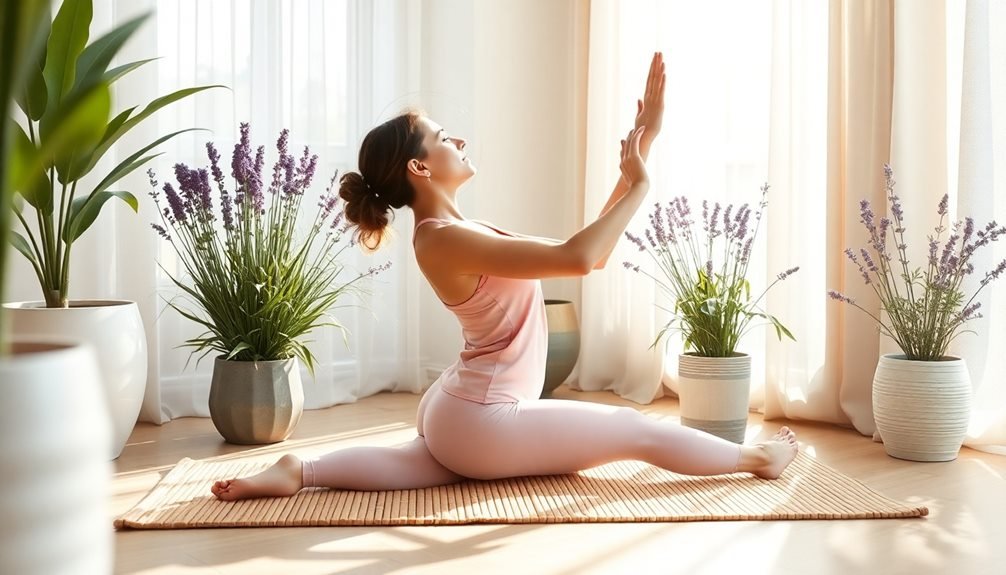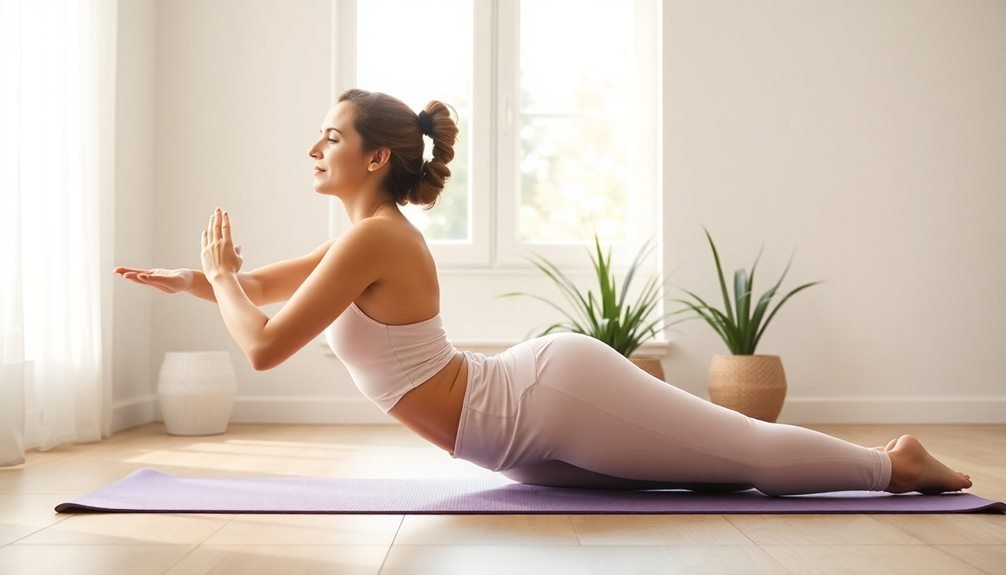Finger painting isn't just for kids – it's a powerful therapeutic tool that can help you reduce stress and anxiety while boosting emotional expression. When you engage in finger painting, you activate multiple sensory regions in your brain, releasing feel-good chemicals like dopamine through repetitive motions. The tactile experience bypasses your inner critic, allowing for authentic self-expression and mindful self-discovery. You don't need artistic skills to benefit from this accessible form of art therapy. Simply set up a comfortable paint station with non-toxic paints and heavy-duty paper, then let your fingers guide your creative journey. There's so much more to explore about this transformative practice.
The Science Behind Finger Painting

Numerous studies have shown that finger painting activates multiple sensory regions in the brain simultaneously. When you dip your fingers into paint, your brain processes both tactile sensations and visual stimuli, creating a unique neural response that can reduce stress and anxiety.
The repetitive motions of spreading paint engage your motor cortex while releasing dopamine, your body's natural feel-good chemical. Your brain's limbic system responds to the textures and temperatures of the paint, triggering emotional memories and promoting emotional regulation.
As you create without brushes or tools, you're accessing primitive neural pathways that existed before complex tool use, connecting to a more instinctual form of expression.
The bilateral stimulation that occurs when you use both hands to paint can help integrate the logical left brain with the creative right brain. This integration strengthens neural pathways and can improve cognitive flexibility.
Research indicates that the freedom of finger painting helps bypass your inner critic, allowing for authentic self-expression while activating the default mode network – the brain state associated with imagination and self-reflection.
Benefits for Mental Health
Your mental health can considerably improve through finger painting therapy, as the tactile process naturally reduces anxiety and stress while giving you a safe outlet for emotional expression.
You'll find yourself naturally entering a mindful state as your fingers glide through the paint, leading to meaningful self-discovery without the pressure of creating perfect art.
The direct contact with paint and canvas creates a uniquely personal experience that helps you process complex feelings and gain deeper insights about yourself.
Reduces Anxiety and Stress
Engaging in finger painting provides adults with a powerful outlet for reducing anxiety and stress levels. As you immerse your fingers in paint and move them across the canvas, your mind shifts away from daily worries and enters a state of mindful focus. This tactile experience triggers the release of endorphins, your body's natural stress-fighting chemicals.
When you're feeling overwhelmed, finger painting lets you express emotions without words. You'll notice your breathing becomes more regulated as you concentrate on the sensory experience, and your muscles naturally relax. The repetitive motions of spreading paint create a meditative state that lowers cortisol levels in your body.
You don't need artistic skills to benefit from this stress-reduction technique. The process matters more than the final product, and there's no pressure to create masterpieces. Instead, you're free to explore colors, textures, and movements that help you decompress.
Whether you spend five minutes or an hour finger painting, you'll likely experience decreased tension in your shoulders, neck, and jaw – common areas where stress accumulates. Regular practice can lead to lasting improvements in your anxiety management and overall stress response.
Enhances Emotional Expression
Finger painting releases emotional expression in ways that words often can't capture. When you dip your fingers into paint and move them across the canvas, you're creating a direct connection between your emotions and the artistic process. This tactile experience helps you bypass mental barriers and access deeper feelings.
| Emotion | Color Choice | Expression Style |
|---|---|---|
| Joy | Yellow/Orange | Swirls & Dots |
| Anger | Red/Black | Sharp Strokes |
| Sadness | Blue/Gray | Flowing Lines |
| Peace | Green/White | Gentle Waves |
You'll find that different emotional states naturally guide your color choices and painting movements. When you're feeling anxious, you might press harder or create chaotic patterns. During peaceful moments, your strokes become more fluid and harmonious. There's no "right" way to express yourself – your paintings are unique reflections of your emotional journey.
The process doesn't require artistic skill, making it an accessible tool for emotional release. You'll often discover that your finished pieces reveal feelings you weren't consciously aware of, providing valuable insights into your emotional state and helping you process complex experiences.
Boosts Mindful Self-Discovery
Through mindful finger painting, you'll discover layers of self-awareness that traditional therapy methods might miss. As you glide your fingers through the paint, you're forced to slow down and connect with your present thoughts and emotions. This tactile experience grounds you in the moment, making it easier to explore your inner landscape without judgment or pressure.
When you engage in finger painting mindfully, you'll notice how your color choices reflect your mood, and your brush strokes reveal your emotional state. You might start with gentle swirls when you're calm, then shift to bold strokes as you process deeper feelings. The process helps you recognize patterns in your thinking and behavior that you hadn't noticed before.
You'll also find that finger painting naturally quiets your inner critic. There's no right or wrong way to create, which frees you to explore your authentic self.
As you examine your finished pieces, you'll gain insights into your subconscious mind – perhaps noticing recurring themes or symbols that represent important aspects of your journey. This self-discovery process becomes a powerful tool for personal growth and emotional understanding.
Setting Up Your Paint Station

Selecting a well-ventilated room with ample natural light will help you create an inviting space for your finger painting therapy sessions.
You'll need non-toxic finger paints, heavy paper or canvas, water containers, paper towels, and a comfortable chair at a table that allows freedom of movement.
Before you begin, protect your work surface with a plastic tablecloth or newspaper, and consider wearing an apron or old clothes to keep paint off your regular attire.
Choose Your Space Wisely
Setting up your finger painting station begins with finding the perfect spot in your home. Choose a well-lit area that's easy to clean and has good ventilation. Natural lighting works best, so consider setting up near a window, but avoid direct sunlight that could dry your paints too quickly.
You'll need a flat, stable surface that's at a comfortable height for sitting or standing. A kitchen table works well, but you might prefer an art desk or even a dedicated craft table. Make sure you've got enough space to spread out your materials and move your arms freely while painting.
Consider the flooring beneath your workspace. If you've got carpet, lay down a plastic drop cloth or old sheet to protect it. Hard floors are easier to clean but can become slippery when wet, so place non-slip mats in your work area.
Keep paper towels or rags within arm's reach for quick cleanup.
Don't forget about access to water. Set up near a sink if possible, or keep a bucket of clean water nearby for rinsing your hands and cleaning supplies.
Essential Tools and Materials
Before you begin your finger painting session, you'll need to gather several key materials and tools. Start with high-quality finger paint that's non-toxic and washable, making certain to select colors that speak to your creative vision.
You'll also want to have a variety of paper options, including heavyweight art paper and smooth poster board, which can handle the moisture from the paints without warping.
- Paint supplies: finger paints (at least 4-6 colors), mixing trays, water container for rinsing, and paper towels for quick cleanup
- Surface protection: plastic tablecloth or newspapers to protect your work area, plus masking tape to secure everything in place
- Paper options: multiple sheets of different textures and weights, including watercolor paper and poster board cut to your preferred size
- Personal comfort items: apron or old clothes, hand wipes, moisturizer for after-session care, and disposable gloves if you're sensitive to paint
Keep these materials organized in a dedicated art bin or container, making them easily accessible whenever you're ready to start your therapeutic painting session.
Remember to check your supplies before each session to verify you won't need to interrupt your creative flow.
Protect Your Surfaces
A pristine workspace creates the foundation for your therapeutic finger painting journey. Before you immerse yourself in the creative process, you'll need to properly protect all surfaces from paint stains and splashes.
Start by covering your table or desk with a waterproof vinyl tablecloth or plastic sheeting, securing the edges with painter's tape to prevent slipping. If you're working on a carpeted area, place a rigid board underneath your protective covering to provide a stable surface.
Don't forget to protect nearby walls with drop cloths if you're planning to work on larger pieces.
Keep paper towels, wet wipes, and an old cloth within arm's reach for quick cleanups. Place newspaper or kraft paper underneath your main protective covering to catch any paint that might seep through.
If you're working near furniture or valuable items, cover them with old sheets or plastic covers.
Consider creating a designated splash zone by marking off your workspace with masking tape on the floor. This visual boundary helps you maintain awareness of your movements and prevents accidental paint transfer to surrounding areas.
Essential Materials and Tools
Three core materials form the foundation of adult finger painting therapy: washable, non-toxic paint, heavy-duty paper, and a comfortable workspace cover.
You'll want to invest in professional-grade finger paints that offer vibrant colors and smooth consistency. Choose paper that's at least 140lb weight to prevent tearing when it gets wet. Your workspace cover should be waterproof and easily cleanable.
Additional essential tools you'll need include:
- Paper towels or wet wipes for quick hand cleaning between colors
- Small water containers for rinsing and creating paint dilutions
- Apron or old shirt to protect your clothing
- Drying rack or flat surface for completed artwork
Consider adding optional materials like textured tools, sponges, or natural items like leaves to create unique patterns.
Store your supplies in a dedicated art box or rolling cart for easy access and organization. When selecting paints, opt for sets that include primary colors, allowing you to mix and create new shades.
Remember to check that all materials are safe for skin contact and won't stain your hands permanently.
Basic Finger Painting Techniques

With your materials ready, mastering fundamental finger painting techniques will reveal your creative potential. Start by warming up with simple dots and lines – press your fingertip firmly onto the paper and drag it smoothly across the surface. Experiment with different pressures to create varying line thicknesses and depths of color.
Try the "swirl technique" by placing your palm flat on the paper and rotating it in circular motions. You'll create mesmerizing spiral patterns that can serve as focal points or background textures.
For broader strokes, use the side of your hand or multiple fingers together, sweeping them across the surface in fluid movements.
Master the "blend and fade" technique by starting with one color and gradually incorporating another, using gentle circular motions with your fingertips. You can create subtle gradients or dramatic color shifts.
Don't forget the "dab and stipple" method – use quick, light touches with your fingertips to build texture and dimension.
For detailed work, use your pinky finger or fingernail edge to scratch fine lines into wet paint or add small accent points to your composition.
Mindfulness Through Color Expression
Mindful color expression serves as a powerful gateway to emotional awareness during finger painting therapy. When you engage with colors intentionally, you're creating a direct channel between your emotions and the canvas. Your color choices often reflect your current emotional state, even if you're not consciously aware of it.
During your finger painting session, try these mindfulness-focused techniques:
- Take three deep breaths before selecting each color, allowing your intuition to guide your choice rather than overthinking the decision.
- Notice how different colors affect your mood – warm colors like red and orange might energize you, while cool blues and greens could create a sense of calm.
- Pay attention to the physical sensation of paint between your fingers, using this tactile experience to stay present in the moment.
- Allow yourself to blend colors organically without judgment, observing how your emotional state shifts as new hues emerge.
As you practice color expression mindfully, you'll develop a deeper understanding of your emotional patterns. This awareness can help you process complex feelings and reduce stress through the simple act of engaging with color.
Overcoming Creative Blocks

Creative roadblocks can strike even during an activity as free-flowing as finger painting. When you're struggling to make that first mark on the paper, try these proven techniques to break through your mental barriers.
Start with simple geometric shapes – circles, squares, or spirals – and let your fingers glide across the surface without judgment. If you're feeling stuck, close your eyes for thirty seconds and move your hands freely, allowing the paint's texture to guide your movements. You'll often find that removing visual pressure helps to release spontaneous expression.
When perfectionism creeps in, set a timer for two minutes and challenge yourself to complete a painting within that timeframe. This constraint eliminates overthinking and forces you to trust your instincts.
Another effective technique is to begin with your non-dominant hand, which naturally reduces expectations and introduces an element of playfulness.
If you're still feeling blocked, try working with just one color at first. As you become comfortable with the medium, gradually introduce additional colors.
Art Journaling With Finger Paints
Art journaling takes finger painting beyond single compositions into a powerful form of ongoing visual storytelling.
You'll discover that combining finger painting techniques with journaling creates a deeply personal and tactile way to process emotions, document experiences, and explore your creative impulses.
Creating an art journal with finger paints lets you build a visual diary that's uniquely yours.
Start with a sturdy mixed media sketchbook that can handle wet mediums, and don't worry about perfection – the raw, intuitive nature of finger painting adds authenticity to your pages.
Here's how to develop your finger paint art journaling practice:
- Begin each session by mixing colors that reflect your current mood.
- Layer your finger paintings with written reflections, using your fingertip to scratch words into wet paint.
- Create textural effects by pressing, swirling, and dragging your fingers across the page.
- Incorporate hand prints as symbolic elements or borders in your layouts.
Remember to protect your work by allowing each page to dry completely before closing your journal, and consider using fixative spray to prevent pages from sticking together.
Group Painting Sessions

Through shared creative experiences, group finger painting sessions offer a unique opportunity to connect with others while exploring artistic expression. You'll find that participating in these communal art activities reduces isolation and builds meaningful relationships with fellow participants who share your creative journey.
During a typical session, you'll gather around tables covered in paper, with various colored finger paints within easy reach. Your facilitator will guide you through structured exercises, like creating collaborative murals or responding to shared prompts. You'll learn to overcome self-consciousness as you work alongside others, discovering that everyone's artistic process is unique and valuable.
Group sessions often incorporate team-building elements, such as passing artwork between participants or creating synchronized movements while painting. You'll notice how the energy in the room shifts as everyone becomes absorbed in the creative flow.
These sessions also provide opportunities for gentle feedback and discussion, where you can share your experiences and insights with others. You'll leave each session feeling more connected to your creativity and your community, having experienced the therapeutic benefits of collective artistic expression.
Displaying Your Finger Paint Art
Once you've completed your finger painting masterpiece, you'll want to showcase it in a way that honors your creative expression.
Consider having your artwork professionally framed to protect the unique texture of finger paint while adding a polished presentation to your therapeutic creation.
You can also explore alternative display methods like hanging your pieces with decorative clips, creating a gallery wall of your progress, or photographing your work to create a digital portfolio.
Framing Your Masterpieces
After dedicating time to create expressive finger paintings, displaying your artwork properly can enhance its visual impact and preserve it for years to come.
When framing your finger painting creations, you'll want to take into account both protection and presentation to showcase your work effectively.
Select acid-free matting and UV-protective glass to prevent your finger paintings from fading or deteriorating over time. You can choose from various frame styles, from minimalist modern frames to ornate vintage designs, depending on your artwork's style and your home's décor.
Here are essential tips for framing your finger painting masterpieces:
- Allow your artwork to dry completely for 24-48 hours before framing to prevent moisture damage.
- Use spacers between the glass and artwork to prevent sticking, especially if your paint is textured.
- Think about floating frames to display the natural edges of your paper if they're particularly artistic.
- Choose frame sizes slightly larger than your artwork to accommodate matting and create visual balance.
Don't forget to sign and date your pieces before framing, as this adds authenticity and helps you track your artistic journey through finger painting therapy.
Creative Display Solutions
While framing your finger paintings offers a traditional display method, you don't have to limit yourself to conventional wall hangings. Consider creating a rotating gallery using clipboard displays, which let you easily swap out pieces as you create new artwork. You can mount several clipboards in a pattern on your wall or lean them on floating shelves.
Transform your finger paintings into functional art by scanning and printing them onto fabric for throw pillows, blankets, or even custom curtains. You'll find several online services that can handle this conversion process. For a more immediate solution, try hanging your pieces with decorative washi tape or creating a clothesline display using twine and mini clothespins.
Turn a blank wall into an interactive gallery by installing a magnetic board where you can frequently rearrange your pieces.
Another option is to create a spiral mobile by hanging paintings at different heights, allowing them to gently move with air currents. For a more protected display, try placing your artwork under glass on coffee tables or using clear acrylic stands to showcase smaller pieces on shelves or desks.
Frequently Asked Questions
Can Finger Painting Improve Motor Skills in Adults With Arthritis?
Yes, finger painting can help improve your hand mobility and dexterity if you have arthritis. You'll strengthen your joints through gentle movements, and the paint's resistance provides a low-impact exercise for your fingers.
How Long Should Each Therapeutic Finger Painting Session Last?
You'll want to keep your therapeutic finger painting sessions between 30-45 minutes. If you're just starting, begin with 20 minutes and gradually increase as you feel comfortable with the activity.
Is Finger Paint Safe to Use for People With Sensitive Skin?
You'll need to check ingredients carefully if you have sensitive skin. Look for non-toxic, hypoallergenic finger paints and do a patch test first. Consider wearing latex-free gloves if you're particularly sensitive.
What Temperature Should Finger Paints Be Stored At?
You'll want to store your finger paints at room temperature, between 60-75°F (15-24°C). Don't let them freeze or get too hot. Keep them in a dry place with tightly sealed lids to prevent drying.
Can Finger Painting Therapy Be Combined With Music for Enhanced Results?
You'll find music and finger painting work beautifully together. Playing calming tunes while you paint can boost creativity, reduce stress, and enhance your emotional expression. Try different genres to discover what resonates best.
In Summary
You've taken the first steps into a powerful form of creative expression that's both healing and fun. Don't let your inner critic hold you back – finger painting isn't about perfection, it's about process. Keep exploring, experimenting, and letting your fingers dance across the canvas. Whether you're painting solo or with others, you're nurturing your creativity and emotional wellbeing with every colorful stroke.





Leave a Reply